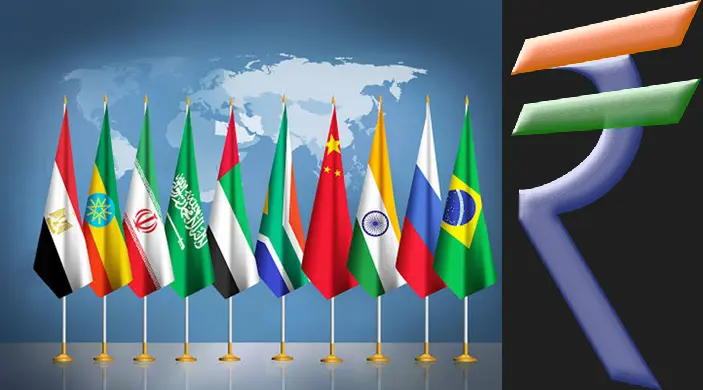
India promotes rupee trade with BRICS nations to counter US tariffs, reduce dollar dependence
A New Chapter in Global Trade: India Chooses Rupee Over Dollar
Trading in Rupees with BRICS Amid US Tariffs – In a surprising move that’s making headlines around the world, India has taken a bold step to promote its own currency, the Indian Rupee for international trade. This decision comes at a time when the United States has imposed steep tariffs on Indian goods, raising tensions between the two countries.
While the Indian government hasn’t officially declared a full switch from the US dollar to the rupee for all BRICS trade, recent actions suggest a strong push in that direction. The Reserve Bank of India (RBI) has eased rules for Special Rupee Vostro Accounts, allowing foreign banks to settle trade in rupees without prior approval. This change is seen as a strategic move to reduce India’s dependence on the dollar and strengthen its economic position.
The BRICS group, Brazil, Russia, India, China, and South Africa, along with new members like Iran, UAE, Egypt, and Indonesia, represents a powerful alliance of emerging economies. Many of these nations have shown interest in trading in local currencies to avoid the risks and costs of dollar-based transactions.
Why Is India Moving Away from the US Dollar?
The US dollar has long been the king of global trade. But using it comes with challenges—especially when political tensions rise. Recently, the US announced a 25% tariff on Indian products, with threats of even higher duties. These tariffs make Indian exports more expensive and less competitive in global markets.
By promoting rupee-based trade, India hopes to:
- Avoid currency conversion fees
- Reduce exposure to dollar fluctuations
- Strengthen the rupee’s global standing
- Build stronger ties with BRICS and other friendly nations
This isn’t just about saving money, it’s about gaining more control over trade and reducing reliance on a currency that’s influenced by another country’s politics.
How BRICS Nations Are Responding
The BRICS alliance has been discussing “de-dollarisation” for years. Countries like Russia and China have already started using their own currencies for some international deals. India’s recent push for rupee trade fits into this larger trend.
Although India’s Ministry of External Affairs clarified that full de-dollarisation isn’t its official agenda, the RBI’s new circular shows a clear intent to make rupee trade easier and more attractive. Countries like Russia and the UAE have already begun settling some trade in rupees, and others may follow.
This shift could lead to:
- More balanced trade relationships
- Less dependence on Western financial systems
- A stronger voice for BRICS in global economic decisions
However, experts warn that building a new trade system takes time. Trust, infrastructure, and mutual agreements are key to making rupee-based trade successful.
What This Means for India’s Future
India’s move to promote the rupee in global trade is more than a reaction to US tariffs, it’s a long-term strategy. By encouraging trade in its own currency, India is aiming to:
- Boost its financial independence
- Protect its economy from external shocks
- Position itself as a leader in the Global South
This could also inspire other developing countries to explore local currency trade, creating a more diverse and resilient global economy.
Still, challenges remain. The US dollar is deeply embedded in global finance, and shifting away from it won’t be easy. India will need to build trust, improve its banking systems, and ensure smooth cross-border transactions.
But one thing is clear: India is no longer playing by old rules. It’s writing a new playbook, one where the rupee takes centre stage.
Also read – BRICS Allies – Trump Declares Ruthless Economic War Over ‘Anti-American’ Shift
Stay informed with the latest news and updates – only on Rapido Updates.